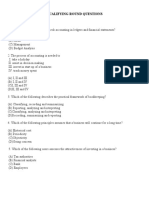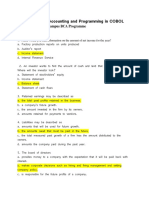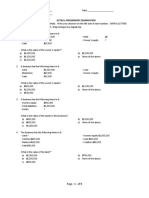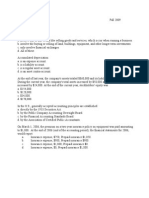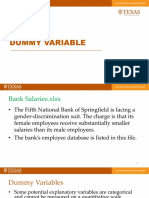Chapter 1 Practice - True or False & Multiple Choice: Take Notes On Class Discussion
Uploaded by
Jennifer Alyce RiosChapter 1 Practice - True or False & Multiple Choice: Take Notes On Class Discussion
Uploaded by
Jennifer Alyce RiosCHAPTER 1 PRACTICE – TRUE OR FALSE & MULTIPLE CHOICE
Take Notes on Class Discussion
true or false
1. All corporations acquire financing by issuing stock for sale on public stock exchanges.
2. Stockholders' equity is the difference between a company’s assets and its liabilities.
3. A company owes $200,000 on a bank loan. It will be reported by the company as Notes Payable.
4. Accounts Payable, Notes Payable, and Salaries and Wages Payable are examples of liabilities.
5. Dividends are subtracted from revenues on the income statement.
6. Revenue is reported on the income statement only if cash was received at the point of sale.
7. Generally Accepted Accounting Principles require companies to distribute their earnings to stockholders.
8. Common Stock is reported as an asset on the balance sheet.
9. The Securities and Exchange Commission (SEC) is the government agency that has primary responsibility
for setting accounting standards in the U.S.
10.The main goal of an accounting system is to capture information about a business so that it can be reported to
decision makers.
multiple choice
1. Financing that individuals or institutions have provided to a corporation is:
A) always classified as a liability.
B) classified as a liability when provided by creditors and as stockholders' equity when provided by owners.
C) always classified as equity.
D) classified as a stockholders' equity when provided by creditors and a liability when provided by owners.
2. Which of the following expressions of the accounting equation is correct?
A) Liabilities + Assets = Stockholder’s Equity
B) Stockholder’s Equity + Assets = Liabilities
C) Assets = Liabilities – Stockholder’s Equity
D) Stockholder’s Equity = Assets – Liabilities
3. Net income is the amount:
A) the company earned after subtracting expenses and dividends from revenue.
B) by which assets exceed expenses.
C) by which assets exceed liabilities.
D) by which revenues exceed expenses.
4. Expenses are reported on the:
A) income statement in the time period in which they are paid.
B) income statement in the time period in which they are incurred.
C) balance sheet in the time period in which they are paid.
D) balance sheet in the time period in which they are incurred.
5. Revenues are:
A) earned by selling goods or services to customers.
B) amounts that owners have contributed directly to the business.
C) cash payments that a business has made directly to its owners.
D) the amount of cash a company has left after it has paid its liabilities.
6. Profit is equal to:
A) revenues minus expenses.
B) assets minus liabilities.
C) the amount of cash that a company has.
D) the amount of cash that owners have contributed to the business.
7. When a company earns net income, the company’s Retained Earnings:
A) increase.
B) decrease.
C) are converted to cash.
D) are paid to stockholders.
8. Alpha sold $2,000 of services to Beta on credit. Beta promised to pay for it next month. Alpha will report a
$2,000:
A) Accounts Receivable.
B) Account Payable.
C) increase in Cash, since Beta is sure to pay next month.
D) net loss.
9. Alpha sold $2,000 of services to Beta on credit. Beta promised to pay for it next month. Beta will report a
$2,000:
A) Account Payable.
B) Accounts Receivable.
C) Decrease in Cash, since it plans to pay for sure next month.
D) Net income.
10. Ace Electronics sold $5,000 of goods to customers of which $3,000 has been collected. Ace Electronics
should report revenues of:
A) $5,000.
B) $3,000.
C) $2,000.
D) $0.
You might also like
- Acct 210-Meta Course-Spring - 2021-22 SyllabusNo ratings yetAcct 210-Meta Course-Spring - 2021-22 Syllabus6 pages
- Intermediate Accounting 2: a QuickStudy Digital Reference GuideFrom EverandIntermediate Accounting 2: a QuickStudy Digital Reference GuideNo ratings yet
- Career Counseling For: Commerce StudentsNo ratings yetCareer Counseling For: Commerce Students36 pages
- 20 Génesis Bonilla Accounting Exercises for TestNo ratings yet20 Génesis Bonilla Accounting Exercises for Test2 pages
- 113 Test Bank For Financial Accounting 1st EditionNo ratings yet113 Test Bank For Financial Accounting 1st Edition24 pages
- 1BIS Financial (Sun - 3-11-2024) - Final Ch.1No ratings yet1BIS Financial (Sun - 3-11-2024) - Final Ch.116 pages
- Tài chính Doanh Nghiệp / Corporate Finance Test 8No ratings yetTài chính Doanh Nghiệp / Corporate Finance Test 810 pages
- Accounting For Managers - PDF 105 Question MCQsNo ratings yetAccounting For Managers - PDF 105 Question MCQs119 pages
- ACCT 284 AD Clem Fionaguo Old Exam PacketNo ratings yetACCT 284 AD Clem Fionaguo Old Exam Packet25 pages
- Accounting CONCEPTS Multiple Choice QuestionsNo ratings yetAccounting CONCEPTS Multiple Choice Questions7 pages
- 1-1 - Simple and Multiple Linear RegressionNo ratings yet1-1 - Simple and Multiple Linear Regression17 pages
- AP-100 (Error Correction, Accounting Changes, Cash-Accrual & Single Entry)No ratings yetAP-100 (Error Correction, Accounting Changes, Cash-Accrual & Single Entry)4 pages
- Cost Accounting Definition - Source - InvestopediaNo ratings yetCost Accounting Definition - Source - Investopedia3 pages
- 6 Column Worksheet and Financial StatementsNo ratings yet6 Column Worksheet and Financial Statements4 pages
- SA 200 Revised Overall Objectives of The Independent Auditor and The Conduct of An AuditNo ratings yetSA 200 Revised Overall Objectives of The Independent Auditor and The Conduct of An Audit36 pages
- 2.1 2.1. Introduction - Terminologies of Accountancy PDFNo ratings yet2.1 2.1. Introduction - Terminologies of Accountancy PDF14 pages
- Information Technology in The Accounting CurriculumNo ratings yetInformation Technology in The Accounting Curriculum4 pages
- Countermeasure There Is Down Payment Exist For The Same VendorNo ratings yetCountermeasure There Is Down Payment Exist For The Same Vendor5 pages
- Chapter 3 Audit Planning, Stategy and ExecutionNo ratings yetChapter 3 Audit Planning, Stategy and Execution32 pages










